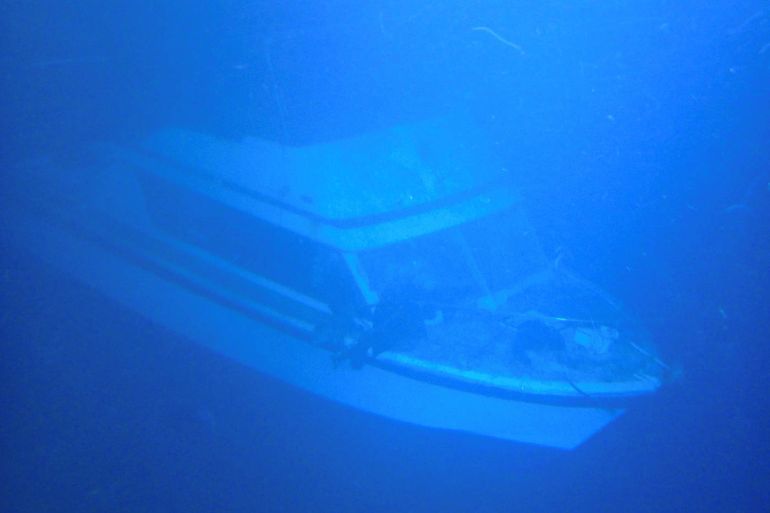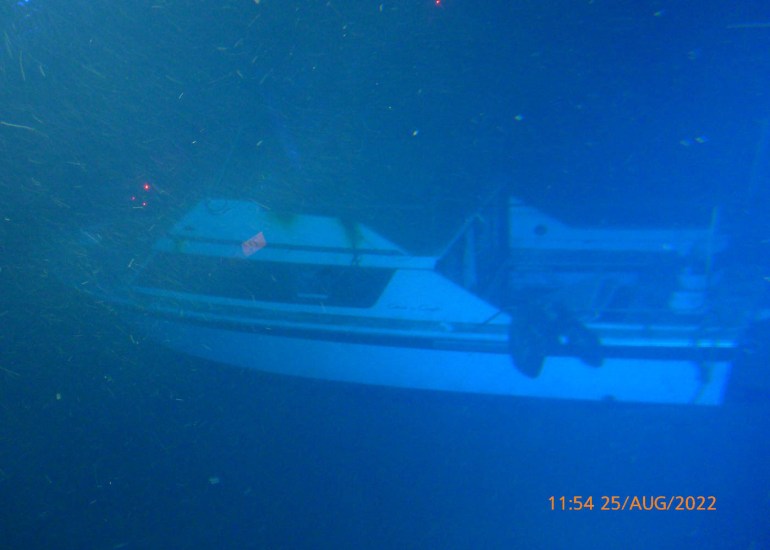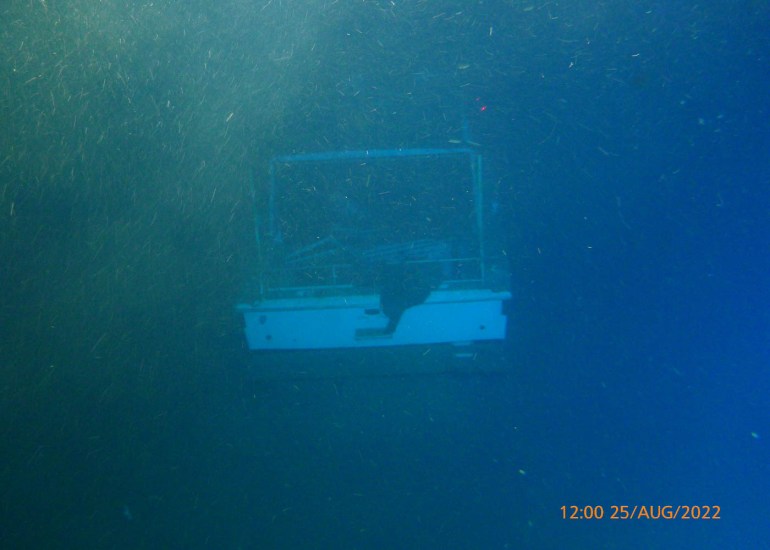‘No evidence’ of navy ramming in April Lebanon boat disaster
An investigation conducted by an Australian NGO says the boat is largely intact, but families dispute the findings.

A report examining the deadly sinking of a boat carrying migrants and refugees off Lebanon in April has found that the wreck of the boat was intact, appearing to contradict claims from victims’ family members that the boat was deliberately rammed by the Lebanese navy, and placing an Australian NGO at the centre of a continuing controversy over who was to blame.
Approximately 40 people are believed to have died in the incident on April 23, which occurred off the coast of Tripoli, in Lebanon’s north, where the country’s economic crisis has hit particularly hard.
Keep reading
list of 3 itemsMinister Amin Salam addresses Lebanon’s economic crises
Photos: Two years after Beirut explosion, Lebanon awaits justice
The Australian NGO AusRelief, which contracted a Pisces VI submarine to attempt to retrieve the wreck and the bodies, has come under heavy criticism, with families saying that the team left Lebanon without completing their mission, and also accusing the Lebanese Armed Forces of obstructing justice for not sharing high-resolution images of the wreck with them.
However, photos taken by the submarine, which were included in a report finalised a week after the mission ended its work on September 2, and which Al Jazeera has seen, appear to show an intact vessel, supporting the report’s findings.
The report states there was no damage to the bow, stern, port side or starboard side, but that there was some damage to the anchor bow roller so that the anchor chain splice had become dislodged.
“It’s black and white to us,” the mission director of AusRelief, which has a number of Australian-Lebanese members, Tom Zreika told Al Jazeera.
“The damage to the anchor line shows in my opinion, that boat was involved in a collision, but it wasn’t a bigger boat causing the damage,” he said.
“My observations are that boat rammed the navy vessel [because] the [damage] is consistent … with the height of the marks on the [navy’s] SS Beirut where there are two white marks on the latter third of the boat.”

That would be consistent with the Lebanese navy’s version of events: that the boat crashed into one of three navy vessels that had gone out to attempt to turn it back.
The report also states that the bodies found – which include a woman who appears to have been attempting to break out of a window with her baby – were in danger of disintegration if the mission attempted to move them.
In response to the report, a lawyer representing some of the victims’ families, Mohamad Fadi Sablouh, told Al Jazeera that it did not contain anything new, and had the same “bad quality photos” that had been taken by the submarine and that they had been shown before.
“They said they would give the families a video and we did not see any video and the photos are not in focus except the women and the baby,” Sablouh said, insisting that the submarine could take 4k resolution images, which should have been provided.
“They said there was damage on the front [of the boat] but the photos didn’t focus on the front.”
A source at the Lebanese Armed Forces, who did not wish to be named as he was not authorised to speak to the media, said that the navy had not tampered with the photographs and videos taken by the AusRelief mission.
“It’s not us, we didn’t take anything from AusRelief, we didn’t keep any copies for the navy of anything, any document, any picture, we just took two or three pictures from the screen of the laptop when the Pisces VI team was showing us just to say we found the boat, that’s why we took those picture, and those pictures were on the army website.”
Cover-up allegations
Sablouh had previously told Al Jazeera that the victims’ families had become even more certain the boat was hit by the Lebanese navy, causing it to sink, due to how the armed forces had handled the photos emerging from the submarine dives.
The lawyer, who has become an unofficial spokesman for the victims’ families, claims that families were restricted from attending a press conference at the end of August in Tripoli.
“I felt something was being concealed and they want to close up everything … I wanted to see the photos, so they took me into the control room to view them, but most of them were not in high resolution,” Sablouh said.
The source at the Lebanese Armed Forces said that the families had not been invited in order to not “make it a [media] circus”.
Sablouh says he tried to push a local Tripoli politician, General Ashraf Rifi, to obtain higher-quality images and videos from the armed forces, but was told that they were still being edited together.
“It’s now been 10 days and still we didn’t get the videos,” Sablouh said. “Why would the military montage the videos instead of us receiving the raw videos from the submarine?
“Why are the people in question, which is the military, supervising everything that is happening in this investigation?”
The Lebanese Armed Forces has not yet replied to an official request for comment.

‘Stuck in the middle’
“We’re advocates for refugees, we never envisaged that we would be put in the middle of two opposing parties, and to make a determination, that wasn’t our role,” Zreika said, lamenting where the AusRelief team finds itself, and stressing that it had not taken sides.
“Our role was to purely come in and locate the bodies and if we couldn’t recover them, give them a service, it wasn’t for the sake of making a legal determination on who was at fault.
“The bottom line for us was to do this purely humanitarian task of giving honour and respect to the refugees,” Zreika added. “Refugees are not garbage, they’re not the refuse of a country, the Lebanese people are suffering and this is the net effect of it.”
Due to the continuing investigation to determine why the boat sank, the AusRelief and Pisces VI team were required to hand over all images of the wreck and bodies – 10 of which were visible including women, children and infants – to the Lebanese Armed Forces and the attorney general immediately after arriving back to shore.
AusRelief also says that its contract with the submarine owner and operator was only for seven days – which had been completed.
AusRelief explained that, due to the way the boat was sitting flat on the sea bed “acting like a suction cup”, the only way to float it to the surface with airbags would be by using an unmanned robotic vehicle to dig a trench around the boat, empty the silt under the hull, and then thread the balloons through it, requiring a professional deep sea salvage team using floating sheerleg cranes, and costing an estimated $9m.
The mission has already cost $650,000.
Lawyer Sablouh said he had been informed the boat was stuck in the seabed “like cement”, and that a body had disintegrated when the mission attempted to retrieve it. Still, he emphasised that clear videos, proving what had been described, had not been shown.
“Why isn’t there just a video of that attempt so they can clear everything, so everything becomes clear, so there’s progress in this investigation,” he asked.
AusRelief said that the information gathered from survivors and authorities, prior to sending out the submarine, suggested that the boat would be broken into two pieces due to a collision, or floating stern up or bow up, meaning that the equipment and team they had contracted would have been able to lift the boat.
Threats
The Australian-Lebanese team had planned to spend a further week in the country, though as the tension between the armed forces and the families increased, Zreika says he was told by navy officials that their safety could not be guaranteed. The armed forces source told Al Jazeera that the group had been threatened by three brothers from Tripoli who owned the boat, and who also had family members on board who died.
“These are real and perceivable threats, what we went through are not made up and if the army is impotent to protect us, then we had to make our own decisions to protect ourselves,” Zreika explained, while stating that other AusRelief staff remained in Lebanon and were continuing the organisation’s work.
Sablouh said he has not heard of any threats being made to the team but confirmed that the sunken boat was owned by the three brothers – who he does not represent.
The source in the Lebanese Armed Forces claimed that the family was involved in smuggling, and may have been forcing the other families to blame the navy for ramming the boat in order to get compensation for those killed, as well as to avoid manslaughter charges themselves.
Sablouh denied that the family wanted compensation, saying that the military general had already offered money to the family who owned the boat, but that it had been rejected.
The lawyer said that the family in question were “just like anyone in Lebanon wanting to flee” and questioned why the navy did not intercept the boat before it left the shore, considering that intelligence services had images of when the boat was boarded and set sail.
“Why did they let it reach where it did before stopping it, and why is this the only boat stopped from the many that try to do the same thing?” Sablouh said.
He further added that if the family – whose names Al Jazeera has withheld for security reasons – had issued threats, the Lebanese security forces should have organised a conference at the end of the mission to explain the findings to the families.
As for the families, Sablouh said, they believe this is just another example of the lack of justice in Lebanon for victims.
“Just like the Beirut Port explosion, they’re letting the people who did what they did get away with it and bring no justice to the victims and the families,” Sablouh said. “The case should have been investigated without the military, who are seen as the perpetrator.”